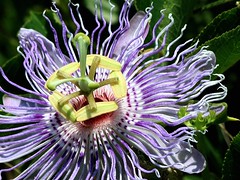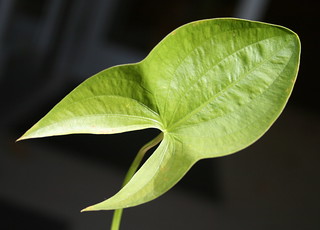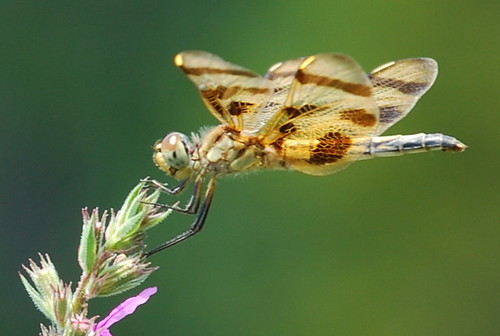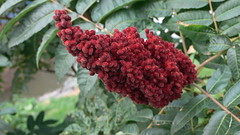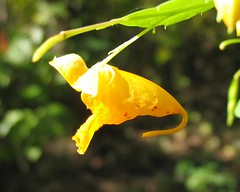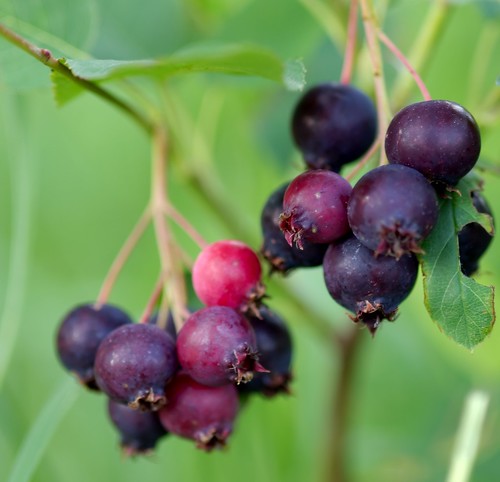The Perseid meteor shower is expected to peak August 11-14. The moon will be a waning crescent that comes up just before sunrise, so there should be dark skies. We just have to fight the haze and clouds of August humidity. The best time to look is in the wee hours of the morning, but you could see meteors at any time after about 9 PM.
Getting outside, inside the beltway: tips on getting outdoors in the Washington, DC area.
Most Popular Posts
-
Photo credit: ilkerender Last year we listed places to swim near DC and places to rent a canoe near DC . Today we return to complete the s...
-
Summer calls out for being on the water. We've found more than a dozen locations where you can rent a canoe or kayak in the Washington, ...
-
What a lovely break in the heat we're having. Here are some things to keep an eye out for in August. Links are to previous LOOK FOR post...
-
This spring has been cold and a little slow, like last year. Morels , in particular, are just starting to show up. Below are all the things ...
-
The Jack in the pulpits are starting to unfurl right now. I've always loved these flowers, showy in their design rather than their color...
-
I've been distracted from the Natural Capital but I haven't totally forgotten about you guys...Here are some of the other things we ...
-
This time last year, the wood frogs were out and had already laid their eggs. As of this morning, the pond where we always find them was com...
-
Our monthly roundup of things to look for this month: Photo credit: InspiredinDesMoines I originally wrote about bald eagles for t...
-
Two of the things we love best about living in the DC metro area are the public transportation system, and the parks. And so, one of our mai...
-
If I had to name my biggest frustration with the nature around DC, the lack of good swimming holes might top the list. Until 7th grade I liv...
Friday, August 7, 2015
Things to look for in August
What a lovely break in the heat we're having. Here are some things to keep an eye out for in August. Links are to previous LOOK FOR posts:
The Perseid meteor shower is expected to peak August 11-14. The moon will be a waning crescent that comes up just before sunrise, so there should be dark skies. We just have to fight the haze and clouds of August humidity. The best time to look is in the wee hours of the morning, but you could see meteors at any time after about 9 PM.
In August we often see hummingbirds in our yard nearly every day. What a treat to watch them go from hovering in mid-air, to zipping away, fast as lightning.
Even more common are the katydids, who chirp just about everywhere in the evening. Even when we lived in Dupont Circle, there was one in the tree outside our apartment building. In the woods you'll hear them by the thousands...and in this post, you can learn to tell apart the calls of the five different species.
Monarch butterflies are in serious decline. But this is the time of year that they are laying their eggs, and if you look closely on milkweed, you may see some stripey caterpillars. Until a few years ago, we brought a few inside every year and raised them. (This post on raising monarchs has been one of the all-time most popular posts on the Natural Capital.) Lately, we've seen so few that I actually choked up a little when I saw a monarch on the milkweed in our backyard.
Joe Pye Weed is another butterfly magnet at this time of year -- not so much for the monarchs as for the swallowtails. Keep an eye out for Joe Pye weed in wetland areas and then watch for the butterflies...look closely and you'll find lots of other pollinators, too.
Joe Pye is one of our tallest flowers; passionflower is surely one of the most exotic-looking. The tropical look of this flower may lead you to think of steamy nights of passion, but the 17th century missionaries who named it claimed to have religion in mind.
Katniss, namesake of the character from the Hunger Games, blooms in August. You won't find enough to subsist on as she did, but if you're a fan of the book it's fun to know the plant.
Dragonflies are common sight this time of year. They hang out around water, because they lay their eggs there and spend their nymph stage as aquatic creatures. In our post we highlighted 6 common species, and shared a video of a dragonfly shedding its aquatic skin to become an adult.
Sumac has extremely distinctive clusters of dark red, hairy berries in the late summer. They're great for making pink lemonade! Check out our post to find out how.
We really enjoyed watching a sphinx moth nectar on jimson weed by the Potomac River a couple of years ago, and may head back to try again. If we end up just watching the sunset by the river, that's not so bad either.
Also out this time of year are the giant silkworm moths, and their large green caterpillars. So beautiful.
What have you been seeing lately? Leave a comment and let us know!
The Perseid meteor shower is expected to peak August 11-14. The moon will be a waning crescent that comes up just before sunrise, so there should be dark skies. We just have to fight the haze and clouds of August humidity. The best time to look is in the wee hours of the morning, but you could see meteors at any time after about 9 PM.
Thursday, July 30, 2015
What's going on at Jug Bay?
We've gone to Jug Bay three times in the last three weeks. The place is teeming with life at this time of year: ospreys calling, dragonflies zipping by, warblers bringing food to their fledglings, and flowers everywhere. Most of these pictures were taken on the short loop trail from the parking lot by the boat dock at Patuxent River Park.
Thursday, July 2, 2015
Things to look for in July
Our monthly roundup of things to look for this month:
I originally wrote about bald eagles for the 4th of July, but they're around all summer -- and some stay over the winter. Still, it's a great time of year to get out on the water and look for them. Matt once had the pleasure of watching an eagle fight an osprey for the fish it had just caught -- evidence of the theiving behavior that made Ben Franklin prefer the wild turkey for national bird.
While you're hanging out in wet places, keep an eye out for moisture-loving jewelweed. It's a pretty flower, a sparkly wonder, a trailside snack, and a soothing skin treatment. What's not to love?
Another moisture-lover is cardinal flower. I used to love cardinal flower just because it's a gorgeous flower. It took a few years before I realized that if you sit quietly for long enough by a large patch, a hummingbird will come by. And that takes it to another level.
I always thought of hibiscus as a tropical flower. It's the kind of thing you expect to see printed on Hawaiian shirts, or tucked behind a hula dancer's ear. But we've got native hibiscus right here in DC. It blooms in July, also in wet areas. (I guess I spend a lot of time on the water in July!)
Also out in July: Chantarelles. They are a choice culinary mushroom prized by chefs around the world. And they grow in Washington, DC. With all this rain, it's been a good year for them already.
Five-lined skinks might be scurrying about as you go looking for these other things -- look for their blue tails!
In July we also find several other wild edibles, including milkweed, black locust beans, and sassafras.
Finally, check out our other posts on great things to do in the summer:
Natural places to go swimming
Public campgrounds
Places to rent a canoe or kayak
Enjoy!
Natural places to go swimming
Public campgrounds
Places to rent a canoe or kayak
Enjoy!
Friday, May 1, 2015
Things to Look For in May
This spring has been cold and a little slow, like last year. Morels, in particular, are just starting to show up. Below are all the things we've highlighted before on the Natural Capital in the month of May. It's getting to be a long list!
What else have you been seeing out there? Enjoy the beautiful weekend outdoors and leave a comment here or on this post on Facebook.
We often make it out to Thomspon Wildlife Management Area in early May to see the trilliums and ladyslipper orchids. I know I usually say that there's so much to see in the DC metro area that roadtrips are unnecessary, but the display at Thompson's is really unbelievable.
Pinxter Azaleas - Some yards are an absolute riot of hot pinks and purples in the spring with azaleas bred from Asian species. But there is actually an azalea native to this area, and it's quite showy in its own right. They're blooming in Rock Creek Park right now.
Tuliptree Flowers - Tuliptrees are one of the dominant species in the forests in and around Washington, DC. But because the trees are so tall, many people have never seen their flowers. You may find some falling on the ground even if you can't see them in the treetops. (But the real treat is, you can drink their nectar.)
Baltimore Orioles - Migrating right along with the tuliptree nectar are the orioles. Learn to recognize their pretty song and you may greatly improve your chances of actually seeing one.
Ruby throated hummingbirds - Need I say more? Love, love, love these birds and I'm always so happy to see them come back in the spring. People have reported seeing them in the area, but I haven't spotted one yet.
There are also many species of migratory warblers -- pretty little songbirds with pretty little songs. In the last several years, we've had a day or two in mid-May when a lot pass through our yard. This post shows some of the species we see the most.
Mountain Laurel - The gnarled, shaggy trunks of mountain laurel (Kalmia latifolia) make it a showy shrub at any time of year. But in late May or early June, they burst into flower.
Tufted titmice - These birds are in the Washington DC area year round, but (like many birds) they're nesting in May. This post was inspired by catching a pair flying back and forth repeatedly to their nest to feed their young, when we went to see the mountain laurels.
Blue flag iris - This gorgeous iris can be found in our local wetlands. It's one of the showiest flowers native to the DC region.
Oyster mushrooms - These are quite possibly my favorite local mushroom. They're not showy like chicken of the woods or early like morels, just a reliable, plentiful mushroom with a nice mushroomy flavor.
Putty root orchid - I had been looking for this flower for years. I finally saw one two years ago, in May.
Serviceberries - We first learned these native, edible fruits as "Juneberries," but they should maybe be called "Mayberries" around here. (Does something already have that name, or is it just a place in tv land?) They should start ripening at the end of the month. They're scattered throughout the woods in the DC area, but you'll get the most fruit from trees that have been planted ornamentally...see our list of some of the best areas we've found, and a few more in the comments to the post.
Eyed click beetles - We love these funky insects and their acrobatics. If you've never seen one in action, check out the videos in our post. For some reason we seem to always see them around this time of year. I'm not sure if that's just chance, or something about their life cycle.
And while you're out looking for all these things, don't forget to start checking for ticks. Lyme disease is rampant in our area, and a big deal if you get it. But if you find a tick within 24 hours of it attaching itself to you, chances are you won't get Lyme. So just suck it up and look for the little bloodsuckers.
What else have you been seeing out there? Enjoy the beautiful weekend outdoors and leave a comment here or on this post on Facebook.
We often make it out to Thomspon Wildlife Management Area in early May to see the trilliums and ladyslipper orchids. I know I usually say that there's so much to see in the DC metro area that roadtrips are unnecessary, but the display at Thompson's is really unbelievable.
Pinxter Azaleas - Some yards are an absolute riot of hot pinks and purples in the spring with azaleas bred from Asian species. But there is actually an azalea native to this area, and it's quite showy in its own right. They're blooming in Rock Creek Park right now.
Tuliptree Flowers - Tuliptrees are one of the dominant species in the forests in and around Washington, DC. But because the trees are so tall, many people have never seen their flowers. You may find some falling on the ground even if you can't see them in the treetops. (But the real treat is, you can drink their nectar.)
Baltimore Orioles - Migrating right along with the tuliptree nectar are the orioles. Learn to recognize their pretty song and you may greatly improve your chances of actually seeing one.
Ruby throated hummingbirds - Need I say more? Love, love, love these birds and I'm always so happy to see them come back in the spring. People have reported seeing them in the area, but I haven't spotted one yet.
There are also many species of migratory warblers -- pretty little songbirds with pretty little songs. In the last several years, we've had a day or two in mid-May when a lot pass through our yard. This post shows some of the species we see the most.
Mountain Laurel - The gnarled, shaggy trunks of mountain laurel (Kalmia latifolia) make it a showy shrub at any time of year. But in late May or early June, they burst into flower.
Tufted titmice - These birds are in the Washington DC area year round, but (like many birds) they're nesting in May. This post was inspired by catching a pair flying back and forth repeatedly to their nest to feed their young, when we went to see the mountain laurels.
Blue flag iris - This gorgeous iris can be found in our local wetlands. It's one of the showiest flowers native to the DC region.
Oyster mushrooms - These are quite possibly my favorite local mushroom. They're not showy like chicken of the woods or early like morels, just a reliable, plentiful mushroom with a nice mushroomy flavor.
Putty root orchid - I had been looking for this flower for years. I finally saw one two years ago, in May.
Serviceberries - We first learned these native, edible fruits as "Juneberries," but they should maybe be called "Mayberries" around here. (Does something already have that name, or is it just a place in tv land?) They should start ripening at the end of the month. They're scattered throughout the woods in the DC area, but you'll get the most fruit from trees that have been planted ornamentally...see our list of some of the best areas we've found, and a few more in the comments to the post.
Eyed click beetles - We love these funky insects and their acrobatics. If you've never seen one in action, check out the videos in our post. For some reason we seem to always see them around this time of year. I'm not sure if that's just chance, or something about their life cycle.
And while you're out looking for all these things, don't forget to start checking for ticks. Lyme disease is rampant in our area, and a big deal if you get it. But if you find a tick within 24 hours of it attaching itself to you, chances are you won't get Lyme. So just suck it up and look for the little bloodsuckers.
Sunday, April 26, 2015
LOOK FOR: Jack in the Pulpit
The Jack in the pulpits are starting to unfurl right now. I've always loved these flowers, showy in their design rather than their color.
But the name Jack in the pulpit never made much sense to me until I lived in New England. In the southern Unitarian church I grew up in, a pulpit wasn't something you could stand in. It was just a stage with a lectern on it.
One day, I walked into King's Chapel in Boston (built 1689) and I got it. Their pulpit isn't a stage; it's a little cubbyhole, with a roof, just big enough for one person to stand in. This architectural arrangement would have been familiar to the early European settlers who gave Jack in the pulpit its name.
As they mature, if you look closely, you'll see that in one "flower" there are actually many tiny flowers, lining the Jack (which botanists call a spathe). These tiny flowers can be either male or female, and often one plant has flowers of only one sex in a given year.
So, sometimes the Jack is really a Jill.
Even better, most plants change the sex of the flowers they make over time. Younger, smaller plants start off producing only male flowers. Older plants have had more time to store up energy in their roots, and will produce more leaves and female flowers.
It's the female flowers, of course, that can produce fruit. You'll see the beautiful red berries ofJack Jill in the pulpits in late summer.
But the name Jack in the pulpit never made much sense to me until I lived in New England. In the southern Unitarian church I grew up in, a pulpit wasn't something you could stand in. It was just a stage with a lectern on it.
One day, I walked into King's Chapel in Boston (built 1689) and I got it. Their pulpit isn't a stage; it's a little cubbyhole, with a roof, just big enough for one person to stand in. This architectural arrangement would have been familiar to the early European settlers who gave Jack in the pulpit its name.
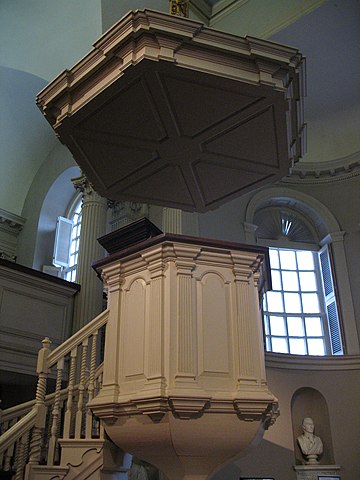 King's Chapel pulpit, taken by Kjetil Ree |  Jack in the pulpit, taken by Susan Tryforos |
As they mature, if you look closely, you'll see that in one "flower" there are actually many tiny flowers, lining the Jack (which botanists call a spathe). These tiny flowers can be either male or female, and often one plant has flowers of only one sex in a given year.
So, sometimes the Jack is really a Jill.
Even better, most plants change the sex of the flowers they make over time. Younger, smaller plants start off producing only male flowers. Older plants have had more time to store up energy in their roots, and will produce more leaves and female flowers.
It's the female flowers, of course, that can produce fruit. You'll see the beautiful red berries of
Friday, April 17, 2015
What's Blooming at Turkey Run?
If you do nothing else this weekend, please, PLEASE go see the bluebells in your favorite river valley. They should be stunning. Last Sunday they were just opening up at Turkey Run, and Wednesday they were very close to peak on the other side of the Potomac (around Lock 7 on the C&O Canal).
And there's so much else going on out there. I've finally gone through the pictures we took from both walks. Here are some highlights:


And there's so much else going on out there. I've finally gone through the pictures we took from both walks. Here are some highlights:

Twinleaf (Jeffersonia diphylla) and spring beauty (Claytonia virginica)

Trout lily (Erythronium americanum) -- there are HUGE patches near where Dead Run crosses the trail from Turkey Run
Subscribe to:
Posts (Atom)





